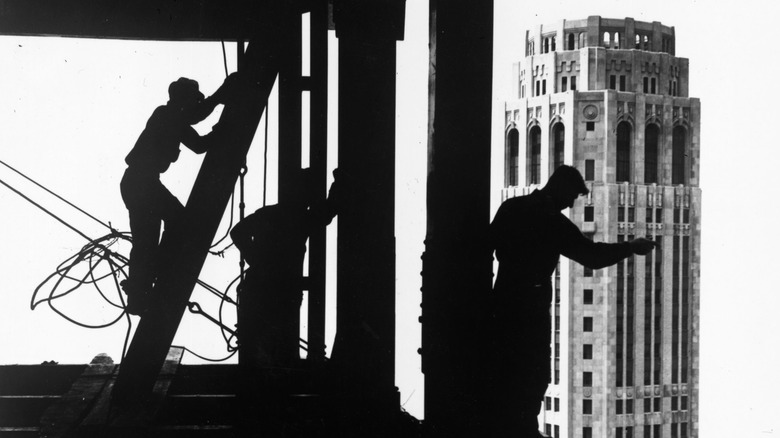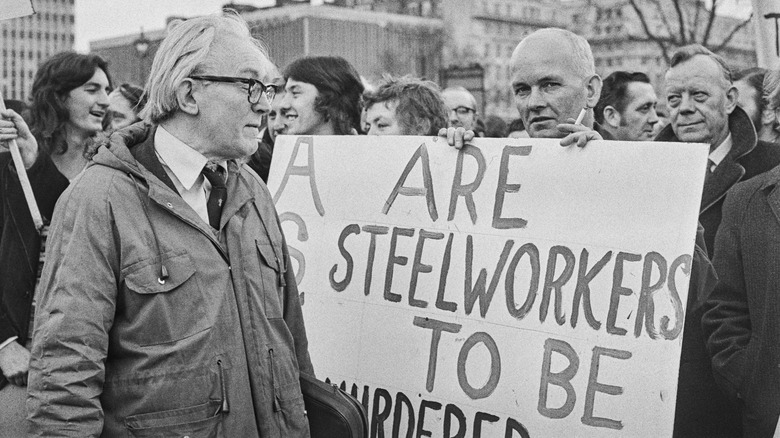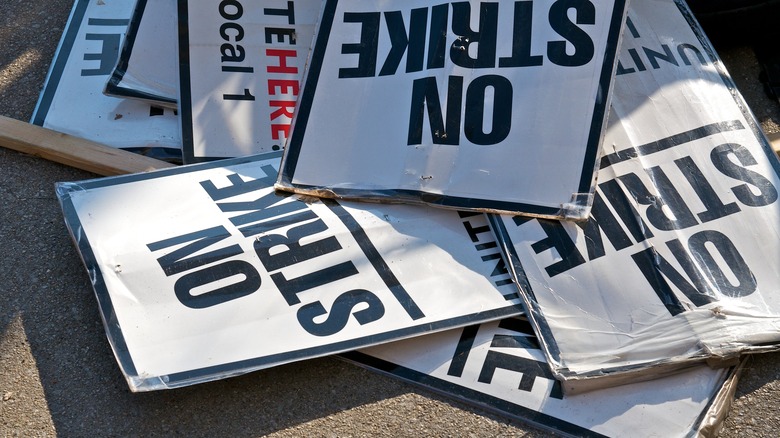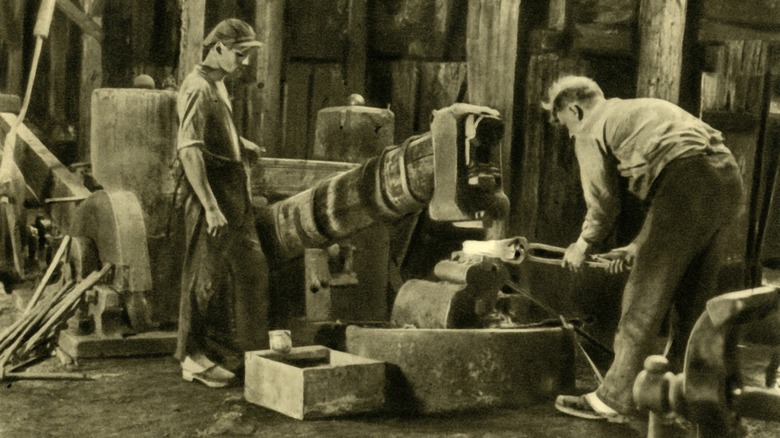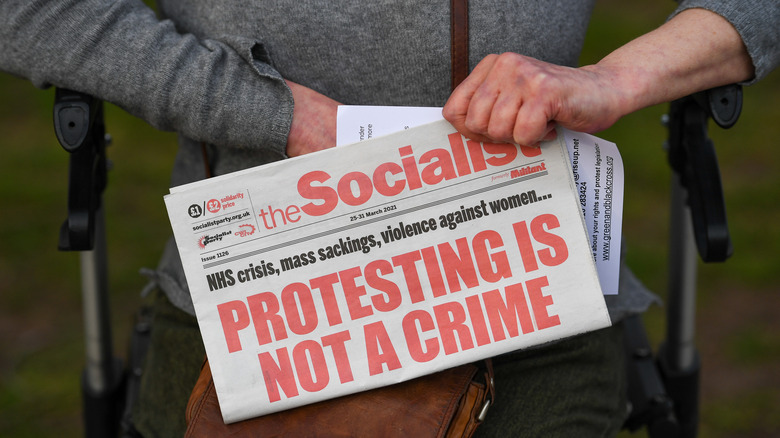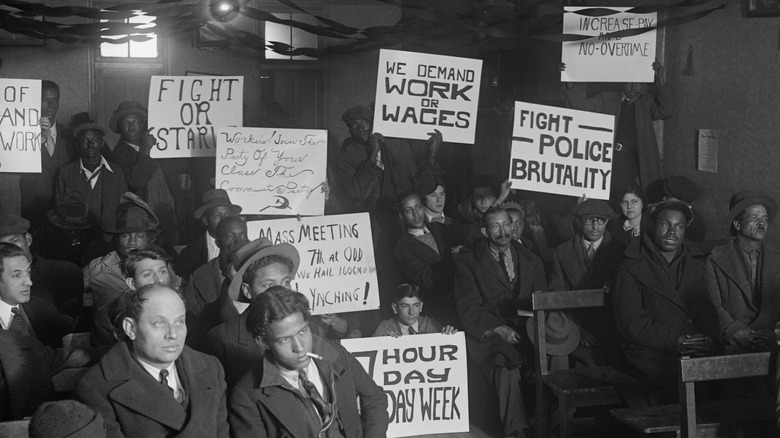What Really Happened During The Steel Strike Of 1919?
The Steel Strike of 1919 was a protest of epic proportions. In its heyday, it featured more than 350,000 workers from diverse backgrounds rallying united against the steel industry giants, per History. They were fighting for something entirely reasonable -– an eight-hour day and a chance to spend time with their families. They were backed by unions and initially supported by the general public.
Yet, even with union backing, this historical strike was doomed from the start. This story is a testament to the fact that all publicity is not necessarily good publicity, and that bad publicity can kill a dream in the making. Place yourself in the shoes of the early 20th-century steelworker in order to reflect on a labor war the working man lost. The story, which should have been a hero's journey, is instead wrought with racism, violence, corruption, and one tragic defeat — all twists of the knife wielded by the press, who successfully compared these workers' wishes to a kind of communism.
Steel workers were underpaid and laboring in dire conditions
It would suffice to say that the steel industry ruled the United States with an unwavering iron fist in the early 1900s. As the largest employer in the nation, the company U.S. Steel, headquartered in the city of Pittsburgh, Pennsylvania, was regarded as one of the most perilous places to work, according to History. Any given day for an employee consisted of grueling 12-plus hour shifts seven days out of the week. Popular periodicals of the time described tumultuous conditions where exhausted workers were subject to life-threatening injuries; their wives held a healthy fear of the now romanticized factory whistles, which in that time period signified a new injury or even a death.
An article published by McLure's Magazine circa 1894 (via PBS) described the conditions of the Homestead Steel Works, located on the banks of one of Pittsburgh's three rivers, as a hotbed of hazard. "On every side tumultuous action seemed to make every inch of ground dangerous," read the piece. "Savage little engines went rattling about among the piles of great beams." In response to this, steelworkers attempting to organize against the powerful steel giants were threatened with actual violence from hired hands, all paid by these companies to do their dirty work. Worst of all, the unthinkable labor was met with a meager wage that was a far cry from a livable salary.
In 1917, workers experienced a brief reprieve to fuel national interests
Like it or not, 20th-century America was built on steel. As PBS noted in their overview of life under the dome of the steel industry at the time, cheap labor — made possible by hazardous conditions and low pay — practically paved the way for the future. With it, national infrastructure climbed to greater heights, literally, with looming skyscrapers and expansive bridges. Meanwhile, steelworkers grew increasingly disgruntled with their wages (paired with increased inflation) and their overall inability to achieve any decent quality of life.
The perfect storm occurred during World War I. Steelworkers, realizing their position of worth as a labor source necessary for winning the war, began to haggle for better living and earning conditions. In 1917, a collective made of workers, employers, and labor unions commonly referred to as the War Labor Board negotiated a new deal, per History.
Negotiated successfully, the agreement between the board and employers resulted in boosted working conditions, with shifts reduced to eight daily hours, all in exchange for a strike moratorium. It was a landslide move, marking the first time in U.S. history that the American government stood in support of labor unions, and worker disputes were settled without the threat of lost labor or the volatile rallies of protest. But in the end, it was all one big façade.
When unsafe working conditions returned, thousands prepared to strike
After the workers enjoyed a short-lived taste of freedom, Big Steel revealed its master plan following the end of World War I in 1918. Post-Armistice Day, U.S. Steel reverted to the same abhorrent conditions as before wartime — in addition to swearing off the unions and underpaying the laborers once again. Worst of all, the 12-plus hour, seven-day shifts returned as if they never left, per History. Once leverage had tipped again toward corporate interest, the working man, toiling in steel, bore the brunt end of this executive decision.
For the first time in history, U.S. labor unions were also siding in favor of corporate interest, attempting to stave off strikes at all costs to keep their newly formed allegiances. Frustrated workers began abandoning said unions in droves. By September of 1919, more than 350,000 steelworkers, comprised of at least 30 different ethnic and racial backgrounds, came together to strike against the steel giants, per Ohio History Connection. The event would prove futile — and for some strikers, fatal.
Racism and bad press foiled the strikers' plans
According to History, the steel industry was in a tailspin, with a jaw-dropping 350,000 employees gone. With World War I over, the War Labor Board wasn't around to negotiate. This enabled Big Steel to play a sneaky hand by wielding the power of the press, subsequently sewing seeds of racism and division. Rather than report the truth — that laborers were underpaid, overworked, and seeking more family time — the press spewed a negative narrative. Reports implied that striking workers were lazy opportunists. Even worse in the eyes of the public at that time, papers painted them as socialists supported by backers in a newly-minted communist Russia.
In order to further divide and conquer, steel mills began replacing white workers with workers of color. This gave way to race riots and ultimately led to a military-backed martial law overseen by state troopers. In a 2019 retrospective, the Chicago Tribune reported that during the Steel Strike of 1919, protestors, made up of 60 factory workers, were injured, and at least four were killed.
1919 was a year of protests and defeat
According to the Chicago Tribune, low wages, long hours, and hazardous conditions in 1919 prompted one-fifth of the nation's workforce to go on strike — a number reflected upwards of 4 million employees. Among those, 350,00 were from the steel industry, and 400,000 more were coal miners. If there's anything to be said for the power of numbers, 1919 as a year of protest should have been a smashing victory for the working class. It wasn't.
History noted in an overview of the event that the Steel Strike of 1919 ended in "crushing defeat," with workers worse off than before and dwindling numbers in union membership. Steel corporations made their position clear, refusing to tolerate strikes or protests of any kind. To make matters worse, the racial seeds of division initially sown to serve corporate interests paved the way for hatred and nationalism. It's also part of the reason hate groups like the Klu Klux Klan (more commonly known as the KKK) were known to congregate in steel towns for the first half of the 1900s.
